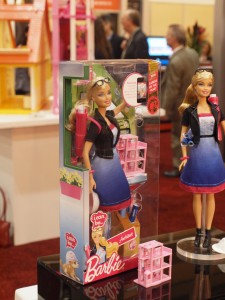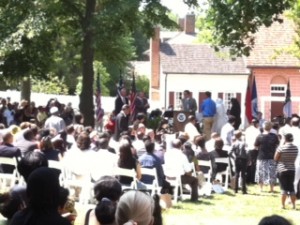It may seem like an oxymoron to put Architect Barbie in the same sentence as social equity. And if you never played with Barbies growing up it may even seem like an oxymoron to put Architect and Barbie together. But in this week when we celebrate our independence, I have been thinking a lot about both topics and how they are related, at least in my life.
I have been a practicing architect for 25 years. And it wasn’t until I was nominated as a Fellow of the AIA in 2008 that I really started thinking about what it meant to be a “woman” architect. And if it meant something different than just being an “architect”.
Creation of Architect Barbie
I grew up playing Barbies AND climbing trees, making forts, skateboarding, playing tennis, riding bikes. But it was “playing Barbies” that was an all –year activity and allowed my girlfriends and me to create our own private worlds where we could be anything we wanted, even if all of our Barbies had the same impossible body and long blonde hair. Each one looked different to us – she wore different clothes, arranged her hair in different ways and “Barb’s Barbie” definitely had a different life approach than “Karen’s Barbie”. So it was very shocking to me when I became an architect and some of my professional friends were disparaging of the fact that I grew up “playing Barbies” – “you didn’t play with Lincoln Logs or FLW’s Froebel blocks?!” – and you still became an architect? Just to show everyone, for my 30th birthday I threw myself a Barbie-themed party and started collecting Barbies.
So, when I heard that Mattel would be launching Architect Barbie as their “I Can Be” Barbie this year, I was thrilled. Even more thrilled when I realized that two of my Buffalo colleagues were behind it, Kelly Hayes McAlonie, AIA and Despina Stratigakos. I won’t repeat the story of how Barbie finally became an architect as Despina eloquently tells their story in this article.
Architect Barbie was officially launched at the AIA Convention in May in New Orleans, but she will not be available to the public until August 15th. As part of the launch, the AIA brought in school groups of little girls to work with architects and design their dream house. I spent an hour one day helping and it was exciting and encouraging.
Social equity as the Third Leg of Sustainability
The central principle of sustainability is the recognition of the interdependence of environmental, economic, and social equity concerns – these are the “three Es” or legs of sustainability. I’m the first one to admit that my understanding of how to integrate the “social equity” component into my sustainability practice is woefully lacking. No problem with environmental. I could even figure out economic probably but social equity? Lately though I’ve been thinking that if our profession could understand how to make its professionals equal despite gender, race or sexual orientation that would be a huge start and improvement. I won’t claim to be an expert or even have any special knowledge regarding social equity for all people in the professions. But what I do know, is that over 50% of all architectural college graduating classes are comprised of women and yet the percentage of licensed women or AIA members has not increased at all. That percentage has hovered between 10 and 15% as long as I’ve been an architect. Where are all the women architects going?
Being a Woman Architect
As a diehard New Yorker I am partial to wearing black of course, but have always liked to add pink, purple, orange, red for a little Sicilian flair. As I’ve become more comfortable with my career I’ve worn these bright colors more and more and now today even have pink steel-toed work boots and matching pink safety glasses.
But being a woman architect isn’t just about what you wear of course. Although, sometimes it seems that’s all that is discussed, certainly with the introduction of Architect Barbie. So many friends and colleagues complained that Architect Barbie is wearing a pink dress, why isn’t she wearing black? And my friend Kelly likes to tell people that the target market age for Barbie is 4 year old little girls NOT 40 year old adult architects! That did get me thinking though, “why do we think Barbie has to wear black?” I wear pink myself and even have an orange drawing tube. I fear that much of this desire to wear black goes back to the fear that women architects shouldn’t wear pink – don’t blatantly remind people that we’re women!
Most of my career I have refused to call myself a “woman” architect. I’m an architect, why do I need to qualify it any more? Do men call themselves “men” architects?! When I was nominated to be a Fellow of the AIA, at least 5 men who were Fellows “advised” me to say in my 35 word “summary” which is one of the most important pieces of the application, that I was the “best woman architect practicing in sustainable preservation”. WHAT? Did you say that you were the best “man” architect when you applied for Fellowship? None of them could understand why they offended me. Needless to say I did NOT indicate I was the best woman anything in my submission. I’ve never thought of myself that way. But do men think of us that way? And even some women? Are we our own worst enemies?
What I can say is that in my 25 years practicing architecture I have definitely observed that women work differently than men. We are typically more collaborative and like to be friends with our colleagues and staff outside of work. I was a partner in a large A/E firm in New York City a decade ago and I constantly got flack from my male partners for being too friendly with my staff. We tend to work more flexibly, not necessarily 9-5. I like to go to yoga at lunch time and then work later for example.
Recognizing the Choices of Being an American citizen
I’m not going to solve this serious question regarding where all the women architects are going in this blog. Deeper thinkers than I are trying to figure it out. And it’s not just architecture of course. There’s a really interesting article in this week’s New Yorker about women in Silicon Valley.
It would seem to me that one of the largest issues is work-family balance. And no matter what, women still take on the biggest family and household burden. I also think women will make choices to improve their personal happiness that men may not, and those choices may not fit with the standard corporate structure. My fellow blogger Kaid Benfield wrote a very intriguing blog about the “pursuit of happiness” last week which I suggest you take a look at.
Yes, there are huge issues regarding social equity with women in our country. But we are very lucky that we are even able to have those discussions, whether we like where some of the answers take us or not. I attended an inspirational event at Old Salem Museums & Gardens on July 4th – a Naturalization Ceremony for 110 of our newest citizens. Listening to the reading of the 46 countries that comprised the birthplaces of our new citizens I couldn’t help but wonder what some of them went through to get to this lovely green square in Winston-Salem, NC, the first place that July 4th was celebrated in our country in 1783.
Listening to the Pledge of Allegiance and the Declaration of Independence at the ceremony, made me really think about what the first line of the Declaration means to so many: “We hold these truths to be self-evident, that all men are created equal, that they are endowed by their Creator with certain unalienable Rights, that among these are Life, Liberty and the pursuit of Happiness.” We know that the civil rights of all of our citizens continue to be topics of discussion and battles – from gender to race to sexual orientation. Some people are more equal than others, and it varies by state (see New York State’s recent passing of the same sex marriage law).
And surprisingly, my delight over the new Architect Barbie seems to represent much of these topics to me – it’s okay to be called a “woman” architect (sometimes!) and to be different (wear pink and be friendly to my staff), it’s okay to wear pink work boots to the construction site and still expect the contractors to listen to my instructions, and it’s okay to pursue happiness in different directions from the rest of the pack. To me, Architect Barbie represents the right to choose how to live my life and how to pursue happiness in my career.
And if you’d like to “subscribe” or follow this blog, True Green Cities, please sign up through the “Subscribe” button at the bottom left of this page. You’ll receive a daily recap when new blogs are posted.



